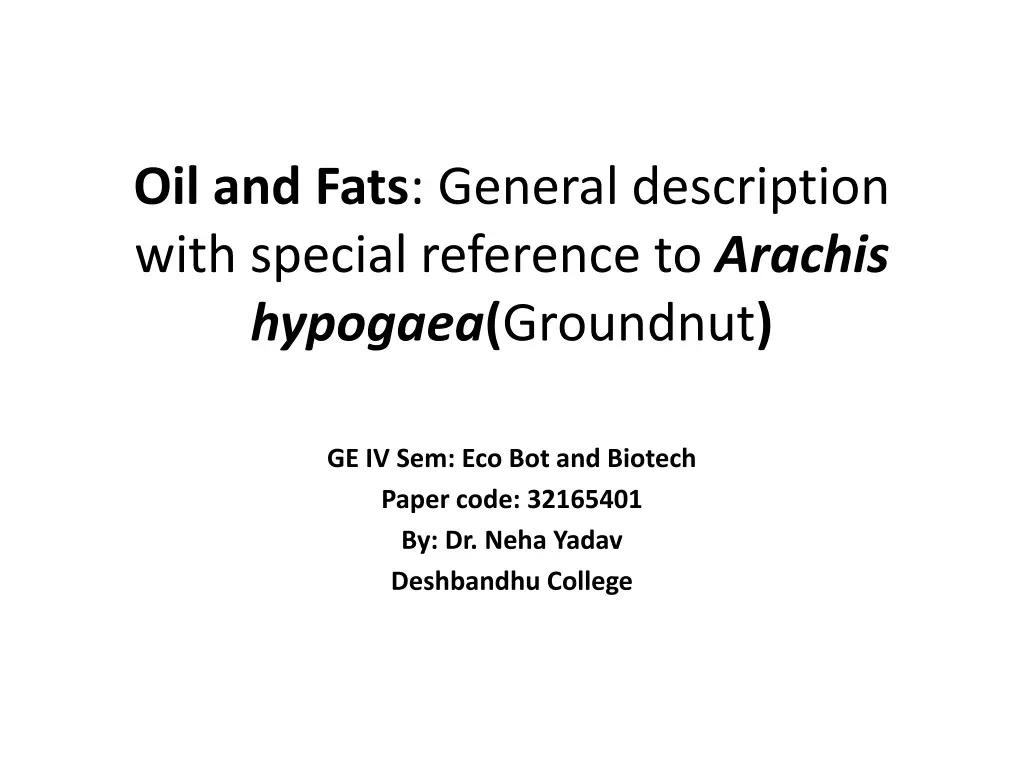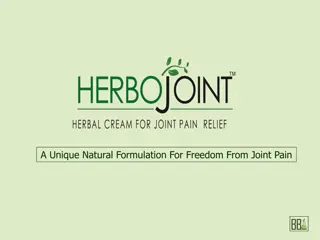
Understanding Oil and Fats: A Detailed Exploration
Delve into the realm of vegetable oils and fats, including their composition, types of fatty acids, distinctions between saturated and unsaturated fats, and the classification of vegetable oils based on their reactions with atmospheric oxygen. Explore the differences between vegetable oils and essential oils, and gain insights into the properties and uses of various oils in this informative guide.
Download Presentation

Please find below an Image/Link to download the presentation.
The content on the website is provided AS IS for your information and personal use only. It may not be sold, licensed, or shared on other websites without obtaining consent from the author. If you encounter any issues during the download, it is possible that the publisher has removed the file from their server.
You are allowed to download the files provided on this website for personal or commercial use, subject to the condition that they are used lawfully. All files are the property of their respective owners.
The content on the website is provided AS IS for your information and personal use only. It may not be sold, licensed, or shared on other websites without obtaining consent from the author.
E N D
Presentation Transcript
Oil and Fats: General description with special reference to Arachis hypogaea(Groundnut) GE IV Sem: Eco Bot and Biotech Paper code: 32165401 By: Dr. Neha Yadav Deshbandhu College
Oil, Fats and Waxes Like Carbohydrates , Fats and Oils contain only C, H and O Though the proportion of three is different Have a relatively low percentage of Oxygen Oils are liquid at room temperature Fats are solid or nearly solid Arachis hypogaea L.
Vegetable oil and Fats are triglycerides of complex organic fatty acids Naturally occurring fats are usually mixtures of triglycerides of various fatty acids with a general formula
Fatty acids Types Fatty Acids are of two principal kinds: Saturated and Unsaturated Common saturated fatty acids in fats are Palmitic (abundant in vegetable fats) and Stearic acid Common unsaturated fatty acids in fats are Oleic acid (one double bond) Linoleic (two double bond) Linolenic (three double bond) Q. Differentiate between Saturated and Unsaturated Fatty acids?
How vegetable oils is different from essential oils (volatile oils/ethereal oils)? They do not volatilise at room temperature They cannot be distilled without being decomposed Leave a permanent greasy stain on paper Being glycerides they form soap with alkali Lack strong taste and odour of essential oils Become rancid on long exposure to air Ex: coconut oil, palm oil, soybean oil, olive oil etc.
Classification of Vegetable oils (Depends on the ability to absorb Oxygen from atmosphere) Three types: 1. Non-drying oils- Remain liquid at room temperature, incapable of forming elastic films (they do not react with atmospheric oxygen), Glycerides of saturated acids and oleic acid with little or no linoleic and linolenic acid, iodine number less than 100, never undergo Oxidation to form a fil and hence not used in paints and varnishes, useful in manufacturing of soaps, as lubricant and as food, these oils are found notably in plants of tropical regions. Example : Groundnut, Palm, Olive, Almond oil etc.
2. Semi-drying oils- Intermediate between Drying and non-drying oils, characteristic in having linoleic and saturated acids, absorbs atmospheric oxygen slowly, produces soft film even after long exposure to air (never form a tough elastic film like Drying oils), iodinenumber lies between 100-130. Example: cootonseed sesame, corn oil etc.
3. Drying oils: These oils are fairly rich in Glycerides of unsaturated fatty acids, particularly Linoleic and Linolenic acids with few oleic compounds, such oils readily absorb oxygen on exposure to air and form a tough, elastic and resistant film, thus important in paint and varnish industries, have high iodine number, usually more than 130. Example: temperate plants like Linseed, safflower, soyabean etc included in this category. Q. Differentiate between the tree types of vegetable oils? Q. Write short note on drying oil or semi-drying or Non-drying oil
Location of oil in plant cells and methods of obtaining oils (For 1Mark Q s) Vegetable oil and fats are located in the form of small insoluble oil droplets within the plant cells. Occur predominantly in seeds, mostly in endosperm and cotyledons. In case of cereals, fat occurs almost exclusively in embryo Olive oil and palm oil are examples where oil is obtained from Fleshy pericarp of Fruit Sometimes oils and fats are also extracted from roots, stems and foliage. Methods of obtaining oils 1.Rendering 2.Mechanical Expression 3.Solvent Extraction
Utilization of Vegetable Oils and Fats As food (concentrated reserve of energy as they contain very little oxygen, have high caloric value, have a role in satiety value of food, delays onset of hunger as fats retard the rate at which food leaves the stomach, adds flavour to food, acts as solvent for fat soluble vitamins, many oils are being used as cooking oil, residue left after extraction of oil called as oil-cake serves important livestock feed) For industrial purpose (employed in non-edible products such as Paints and Varnishes and Lacquer, soaps, detergents, synthetic fibres, polishes, candles, cosmetics etc) In Pharmaceuticals (Fixed oils and fats are used for their soothing properties)
Refer: Economic Botany in the Tropics, Fourth edition by S.L. Kochhar (2012)






















